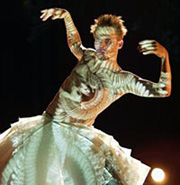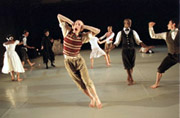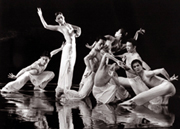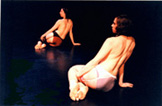Dancing in Puddles
Rain
Rosas
Howard Gilman Opera House
Brooklyn Academy of Music
Brooklyn, New York
November 13, 2003
By
Meital Waibsnaider
Copyright
©2003 by Meital Waibsnaider

Within the
first moments, Keersmaeker planted the seeds for the seventy-minute piece.
I think in this one evening we may have witnessed every combination of
ten dancers imaginable. But watching Rain unfold was more than a thirst-quenching
treat.
read review
Letter from New York
Mindy Aloff's Letter from New York will return in two weeks. If you've missed an earlier Letter, you can catch up:
Troupe Movements
4th
Annual DanceEuropa
Tel-Aviv, Israel
October 9 - November 2, 2003
by
Gail Golod
copyright
© 2003 by Gail Golod
November 10, 2003
 Last
Sunday marked the close of the fourth annual DancEuropa in Tel-Aviv. The
festival featured 14 performances by five visiting European companies—from
France, Austria, Holland, and Finland. In the attractive bilingual (Hebrew-English)
souvenir program, the head of The European Commission Delegation in Israel
states that: “DancEuropa is an initiative of the Suzanne Dellal
Center and the representatives of the European Union in Israel to expose
Israeli audiences to the richness and diversity of contemporary European
dance…as part of the ongoing efforts to strengthen cultural ties
between Israel and the European Union.” Additional sponsors were
the Tel-Aviv Opera, the municipality of Tel-Aviv-Yaffo, and Israel’s
Ministry of Foreign Affairs.
Last
Sunday marked the close of the fourth annual DancEuropa in Tel-Aviv. The
festival featured 14 performances by five visiting European companies—from
France, Austria, Holland, and Finland. In the attractive bilingual (Hebrew-English)
souvenir program, the head of The European Commission Delegation in Israel
states that: “DancEuropa is an initiative of the Suzanne Dellal
Center and the representatives of the European Union in Israel to expose
Israeli audiences to the richness and diversity of contemporary European
dance…as part of the ongoing efforts to strengthen cultural ties
between Israel and the European Union.” Additional sponsors were
the Tel-Aviv Opera, the municipality of Tel-Aviv-Yaffo, and Israel’s
Ministry of Foreign Affairs.
read review
Bayadère/Bayadère
La
Bayadère
Royal Ballet
Royal Opera House, Covent Garden
London, U.K.
21 October 2003
La
Bayadère
Mariinsky Ballet
Detroit Opera House
Detroit, Michigan
2 November 2003
By
Leigh Witchel
copyright
© 2003, Leigh Witchel
It’s been a busy year for La Bayadère. The Royal Ballet opened its season in London with Natalia Makarova’s Soviet influenced version, but with the final act restored. Londoners got to compare it with the Mariinsky’s (called the Kirov on tour for familiarity’s sake) historically reconstructed version earlier this year (see the print edition of Dance View, Autumn ’03 for a report by Jane Simpson). New York has already seen this restored production, but on the Mariinsky’s current tour to other parts of the United States, including the Detroit Opera house, they are bringing the previous Soviet version of the ballet that omits the destruction of the temple.
Even with
her restoration of the final act, Makarova’s production resembles
the Soviet version of the ballet; it’s what she knew and brought
with her to the west, and Mariinsky ballerinas could be seen in both versions.
The Royal Ballet imported Daria Pavlenko as Nikiya for few performances
in October, and at the Michigan Opera House she was scheduled to perform
on the same night as scheduled in London in what was a remarkable act
of bilocation, wishful thinking, or the usual cavalier attitude of the
Mariinsky management towards reporting casting. A performance allotted
to Pavlenko ended up being danced by Diana Vishneva, with Igor Zelensky
also listed as her partner. Of course, it wasn’t Igor Zelensky dancing;
that would have been too simple and unconfusing. Andrian Fadeyev danced
Solor unannounced and uncredited.
read review
[republished from last week's Midweek Update]
Staging Martha Graham's Celebration
An Interview with Yuriko
By Mindy Aloff
Copyright © 2003 by Mindy Aloff
Among Barbara Morgan’s very greatest images of the Martha Graham Dance Company are the handful of her ensemble, rocketing in synch, from Celebration (given its première in 1934, photographed sometime between 1936 and 1941). Graham, herself, is nowhere to be seen; she never performed in the dance. Some of those who did, though, have recorded their experiences, which might lead one to think that the dance consisted of jumping from beginning to end. (Various estimates put the number of jumps in it at around 150.) “It was sensational because we jumped the whole time,” May O’Donnell told critic Tobi Tobias in 1981. In Robert Tracy’s Goddess: Martha Graham’s Dancers Remember, Pearl Lang recalls that “the technique is very difficult. They used to teach the difficult jumps from Celebration in class.” Jane Dudley, also interviewed by Tracy, remembered: “When I was asked to join Martha’s company, I had to learn Martha’s dance Celebration, which nearly killed me. The fact is, enthusiastic as I was, and with as well-endowed a body [as] I had, I wasn’t prepared for the stamina a dancer needed for Celebration.” An especially vivid account is Bonnie Bird’s, in her memoir Bird’s Eye View: Dancing with Martha Graham and on Broadway:
“In
1933 Martha choreographed Celebration, a marvelously energetic
dance suggestive of atoms and molecules rebounding to and fro, being propelled
in space. We ran backward with tiny steps on half-toe, knees straight,
similar to bourrées, which created a feeling of vibratory momentum.
I jumped in the center of the group until my legs ached. Others split
off like frecrackers spewing out in different directions. The dance was
impersonal, yet exciting, and we all loved it. The fact that we danced
Celebration with impassive faces was puzzling to people in the audience.
Martha had expunged smiling long before this.”
read article
Underdeveloped Pursuit of Happiness
"Pursuit
of Happiness—Evening of Dance, Words, and Live Music"
Nancy Havlik Dance Performance Group
Jack Guidone Theater
Joy of Motion Dance Center
Washington, DC
November 15, 2003
by Tehreema
Mitha
copyright © 2003 Tehreema Mitha
 The
evening started with a “Monologue” on the cello played by
Jodi Beder, a principal cellist of Princeton Symphony Orchestra. The piece
was created by composer Minako Tanahashi Tokuyama and we were told that
it blended her oriental background and western sensibilities and was based
on the extreme emotional pitches of kabuki theater. To my mind this was
not the piece to start with. It had far too many short bits, in which
you barely got into the mood, and which is not what one associates with
the oriental way of preparing an audience. A little passage would end
just when you started to really listen, and then the cellist would stop
and turn the page.
The
evening started with a “Monologue” on the cello played by
Jodi Beder, a principal cellist of Princeton Symphony Orchestra. The piece
was created by composer Minako Tanahashi Tokuyama and we were told that
it blended her oriental background and western sensibilities and was based
on the extreme emotional pitches of kabuki theater. To my mind this was
not the piece to start with. It had far too many short bits, in which
you barely got into the mood, and which is not what one associates with
the oriental way of preparing an audience. A little passage would end
just when you started to really listen, and then the cellist would stop
and turn the page.
read review
EXTRA!
November 21, 2003
SALVATION GOREYFIED
Riedel
Dance Theater
Joyce SoHo
New York, NY
November 20, 2003
by
Mary Cargill
copyright © 2003 by Mary Cargill
 Jonathan
Riedel’s The Unsightful Nanny, based on Edward Gorey’s
work and performed as part of last years Limón season at the Joyce,
was one of the most unusual and mordantly funny works seen in sometime.
So the news that Riedel had formed a company formed mainly from Limón
dancers to present his own works, including a new Gorey piece, was exciting
news. His company (making its Joyce debut) is performing at the Joyce
Soho from November 20th through the 23rd.
Jonathan
Riedel’s The Unsightful Nanny, based on Edward Gorey’s
work and performed as part of last years Limón season at the Joyce,
was one of the most unusual and mordantly funny works seen in sometime.
So the news that Riedel had formed a company formed mainly from Limón
dancers to present his own works, including a new Gorey piece, was exciting
news. His company (making its Joyce debut) is performing at the Joyce
Soho from November 20th through the 23rd.
read review
Dancing that Breathes
Suzanne
Farrell Ballet
[Presented by Cal Performances]
Zellerbach Hall
Berkely, California
November 14, 2003
By Rita Felciano
copyright © 2003 by Rita Felciano
Not having lived through the Golden Age of New York City Ballet, the moans and groans about paradise lost have always evoked more sympathy than understanding. Maybe we do live in an Iron Age, but if you have only seen Violette and Maria and Patty and Melissa and Merrill dance on tape on a very small screen, it’s difficult to assess what exactly you have missed. But now the Golden Girl of the New York City Ballet, Suzanne Farrell, has opened the door for a glimpse into what may have been, after all, a garden of earthly delights.

read
review
Tricky Terrain
Moon
Water
Cloud Gate Theater
Zellerbach
Hall,
Berkeley, California
November 1, 2003
By
Ann Murphy
Copyright ©2003 by Ann Murphy
 Two
weeks ago, the 30-year-old Cloud Gate Dance Theatre of Tawain presented
a 90 minute movement composition called Moon Water, (1998) by
company director Lin Hwai-min, set to Bach's solo cello work, and based
on an otherworldly vocabulary of coiling, squatting, undulating movement.
In style it crosses Butoh and Graham, tai chi and Chinese folk dance,
ballet and Chi Kung, and had about it the earnest, often beautiful experimentalism
that choreographers from China have been producing for a few decades.
It was terrain the 20 supple performers crossed with ghostly agility and
an extreme mastery of the flesh that was reminiscent of the control achieved
by Chinese acrobats.
Two
weeks ago, the 30-year-old Cloud Gate Dance Theatre of Tawain presented
a 90 minute movement composition called Moon Water, (1998) by
company director Lin Hwai-min, set to Bach's solo cello work, and based
on an otherworldly vocabulary of coiling, squatting, undulating movement.
In style it crosses Butoh and Graham, tai chi and Chinese folk dance,
ballet and Chi Kung, and had about it the earnest, often beautiful experimentalism
that choreographers from China have been producing for a few decades.
It was terrain the 20 supple performers crossed with ghostly agility and
an extreme mastery of the flesh that was reminiscent of the control achieved
by Chinese acrobats.
read
review
Exposed
under/world
Roseanne
Spradlin
The Kitchen
New York, NY
November 8, 2003
By
Susan Reiter
copyright © 2003 by Susan Reiter
 For
those who might squirm a bit when a choreographic moment puts a dancer's
crotch more or less in our face (and perhaps wonder whether the dancer
feels awkward in that position), Roseann Spradlin's Under/world tells
us to get over it, quickly. Just about every inch of her three dancers'
anatomy is in our face.
For
those who might squirm a bit when a choreographic moment puts a dancer's
crotch more or less in our face (and perhaps wonder whether the dancer
feels awkward in that position), Roseann Spradlin's Under/world tells
us to get over it, quickly. Just about every inch of her three dancers'
anatomy is in our face.
read review
Kung Fu Kitsch
Shaolin
Warriors
[presented by the Washington Performing Arts Society]
Lisner
Auditorium
Washington, D.C.
November 15, 2003
By Lisa Traiger
copyright © 2003 by Lisa Traiger
Cultural
continuity may be why the Shaolin monks say they tour, sharing their spectacularly
fearless, breathe catching kung fu techniques with Western audiences.
The show they put on—and it definitely is a show—is two hours
of tumbling tricks and hand-to-hand and armed weapons combat. Whips, axes,
broadswords, spears, daggers, and even fans provide thrills and chills.
Ever see a man mince bok choy on his stomach? How about a threesome who
crack metal bars and wooden sticks in two on their foreheads? Or a man
cracking two-handed double whips at the speed of sound? How about the
guy who reclines on a bed of swords, a bed of nails above him and a cement
block atop that. Then comes the sledgehammer down to crack that block
in two. Talk about cringe inducing, spine tingling kinesthesia. All together
now, let out a deep breathe.
read review
A Tasteless Beauty
Sleeping
Beauty
Saba Dance Theatre
(presented by French Institute Alliance Francaise)
Florence Gould Hall
New York, NY
November 15, 2003
By
Susan Reiter
copyright © 2003 by Susan Reiter
 What
are all these children making of all this? I found myself wondering as
this stupefyingly tasteless and amateurish vanity project unfolded in
front of what was largely a family audience. The Alliance Francaise's
dance offerings are sporadic, and in the past have featured some respected
and adventurous contemporary French troupes. What led them to present
the Saba Dance Theatre—named for its artistic director/choreographer/costume
designer, the single-named (like Cher, with whom he shares a penchant
for extravagant, tasteless get-ups) Saba, is a mystery.
What
are all these children making of all this? I found myself wondering as
this stupefyingly tasteless and amateurish vanity project unfolded in
front of what was largely a family audience. The Alliance Francaise's
dance offerings are sporadic, and in the past have featured some respected
and adventurous contemporary French troupes. What led them to present
the Saba Dance Theatre—named for its artistic director/choreographer/costume
designer, the single-named (like Cher, with whom he shares a penchant
for extravagant, tasteless get-ups) Saba, is a mystery.
read review
|
|
|
|